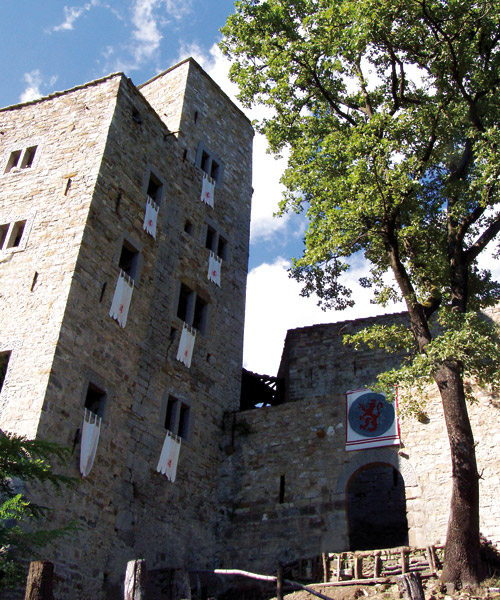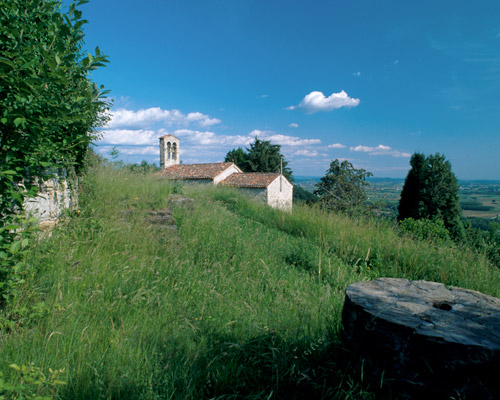CUCAGNA CASTLE
It was in1027 when Patriarch Popone granted permission to Odoric of Auspergh, a Carinthian nobleman, to erect a castle in Faedis as part of a more complex project called “aristocratic colonization,” which involved fortifying Friuli to make it safer against barbarian invasions.
Odorico of Auspergh chose to build his manor on the hill of Cucagna, from which he could dominate the Grivò valley, a place of transit and access to the Friulian plain, and Faedis. The castle was built, probably on a late antique early medieval fortification placed to control the route from Forum Iulii (Cividale) to Gemona, in a place difficult to attack and besiege.
The complex, currently under advanced restoration by the Institute for the Reconstruction of Chucco Zucco Castle, is characterized by its tall quadrangular tower with elevated pusterla. Not far away was the fortified domus of which the walls and a large cistern remain.
From the data collected, it appears that in 1325 the residential domus was expanded, which, however, a century later, was abandoned along with the castle when the nobles of Cucagna, as the Auspergh were later called after the hill on which they built the castle, moved to their villas in Ronchis, Faedis, Udine and Cividale.

Cucagna Castle can be reached via the ancient medieval path from Borgo S. Anastasia, on the road to Canal di Grivò, in Faedis.
THE CASTLE OF ZUCCO
In November 13, 1248, Patriarch Bertoldo granted Adalpretto of Cucagna permission to erect a castle on the hill known as “Rodingerius” above Faedis. This suggests that during these first one hundred and fifty years in Faedis the Cucagna family grew enormously larger and richer.
The manor was built, as was the custom, at a lower point than the pre-existing one, almost a form of submission and respect toward the older and more illustrious first one. The new castle known as Zucco (from zuc = hill), initially owned in communal ownership by the Cucagna nobles, would later be permanently ceded to a branch of the same family, which would take the namesake name. The new complex, larger than the pre-existing one, had an articulated plan with double walls, and large moat. Within the enclosure stood the keep tower, the fortified domus, some housing structures and even the castle chapel, which can still be admired today.
In the 15th century Zucco Castle, which suffered the same fate as Cucagna Castle, was abandoned for the more comfortable and cozy villas on the plains, and also in the same century it was inceded by the Venetians. This castle, like that of Cucagna, suffered much damage in this last century, especially during World War I and World War II.

For several years it has been the subject of recovery, by the Chucco Zucco Castle Reconstruction Institute, currently the work is on standby while waiting for a new entity to open the site for the final recovery in view of the Terra dei Castelli Archaeological Park of the municipalities of Attimis, Faedis and Povoletto.
Zucco Castle can be reached via the ancient medieval path from Borgo S. Anastasia, on the road to Canal di Grivò, in Faedis.
THE CASTLE OF
SOFFUMBERGO
Soffumbergo Castle was built in the 11th century and owes its importance mainly to the fact that for many centuries it was the home of the Patriarch of Aquileia. The place name Soffumbergo derives from the medieval German word Scharfenberg, which means sharp mountain or sharp fortress, and in fact the hill on which it was built has precisely these characteristics.
The territory over which it ruled included Campeglio, Raschiacco, Colloredo, Valle and Canale. Due to its destruction in 1441 by the Cividale people, only the foundations of the towers, enclosure and residential domus remain of the ancient manor.
The ancient castle chapel, on the other hand, is still totally intact thanks to numerous renovations and restorations. In 1993, some archaeological excavations were carried out, which unearthed several artifacts. Among them were numerous fragments of tableware and fire pottery with interesting decorative motifs, bronze objects, arrow cusps and elements of armor, dating from the 13th-14th centuries.

Soffumbergo Castle can be reached via Castellana Street in Campeglio, a side road to Raschiacco.